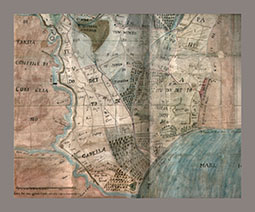Autore: C. Colelli
Scarica l’articolo in formato .pdf: Un mito nella palude: “Non bisognava esplorare il deserto di Sahara per trovare Sibari”
 Alla fine dell’VIII secolo a.C. coloni greci provenienti dall’Acaia fondarono, nella pianura alluvionale fra i corsi dei fiumi Sybaris e Krathis, l’apoikia di Sybaris. La città divenne simbolo di lusso e ricchezza presso gli antichi prima di essere distrutta nel 510 a.C. Nello stesso luogo vennero poi fondate la panellenica Thurii (444 a.C.) e la colonia latina di Copia (194 a.C.). Al tramonto dell’Evo Antico la piana, un tempo famosa per la sua fertilità, divenne malsana e paludosa: Copia fu abbandonata e i suoi edifici coperti da acqua e fango. Durante lunghi secoli di oblio l’area divenne un’immensa palude e delle tre città sovrapposte rimase solo il ricordo. Nel Settecento, proprio in prossimità della foce dei due fiumi, interessate nel corso dei secoli da profonde mutazioni, erano visibili antiche vestigia che storici, geografi e viaggiatori del Grand Tour non avevano dubbi ritenere le rovine di Sybaris. Dopo l’Unità d’Italia iniziò un ampio e costoso programma di ricerche mediante il quale si provò, invano, a mettere in luce i resti dell’antica polis. Solo negli anni Trenta del Novecento, in seguito ai lavori di bonifica della piana, Umberto Zanotti Bianco, intellettuale inviso al regime fascista, riuscì a individuare, nell’area oggi nota come Parco del Cavallo, i resti di Copia sorta sul luogo già occupato da Thurii e Sybaris.
Alla fine dell’VIII secolo a.C. coloni greci provenienti dall’Acaia fondarono, nella pianura alluvionale fra i corsi dei fiumi Sybaris e Krathis, l’apoikia di Sybaris. La città divenne simbolo di lusso e ricchezza presso gli antichi prima di essere distrutta nel 510 a.C. Nello stesso luogo vennero poi fondate la panellenica Thurii (444 a.C.) e la colonia latina di Copia (194 a.C.). Al tramonto dell’Evo Antico la piana, un tempo famosa per la sua fertilità, divenne malsana e paludosa: Copia fu abbandonata e i suoi edifici coperti da acqua e fango. Durante lunghi secoli di oblio l’area divenne un’immensa palude e delle tre città sovrapposte rimase solo il ricordo. Nel Settecento, proprio in prossimità della foce dei due fiumi, interessate nel corso dei secoli da profonde mutazioni, erano visibili antiche vestigia che storici, geografi e viaggiatori del Grand Tour non avevano dubbi ritenere le rovine di Sybaris. Dopo l’Unità d’Italia iniziò un ampio e costoso programma di ricerche mediante il quale si provò, invano, a mettere in luce i resti dell’antica polis. Solo negli anni Trenta del Novecento, in seguito ai lavori di bonifica della piana, Umberto Zanotti Bianco, intellettuale inviso al regime fascista, riuscì a individuare, nell’area oggi nota come Parco del Cavallo, i resti di Copia sorta sul luogo già occupato da Thurii e Sybaris.
At the end of the 8th century BC Greek people from Achaia founded Sybaris in the alluvial plain between the courses of the Sybaris and Krathis rivers. The city became a symbol of luxury and richness among the ancients before being destroyed in 510 BC. The Panhellenic Thurii (444 BC) and the Latin colony of Copia (194 BC) were then founded in the same place. After the fall of Roman Empire, the plain, once famous for its fertility, became unhealthy and swampy: Copia was abandoned and its buildings covered by water and mud. During long centuries of oblivion, the area became an immense swamp, the rivers changed their course several times. Water and mud covered the ruins and only the memory of the three cities remained. In the eighteenth century, just near the mouth of the two rivers, ancient vestiges were visible that historians, geographers and travelers of the Grand Tour had no doubts believe the ruins of Sybaris. After the unification of Italy, a large and expensive research program began through which archaeologist tried, in vain, to uncover the remains of the ancient polis. Only in 1932, after the reclamation of the plain, Umberto Zanotti Bianco, an intellectual disliked by the Fascist regime, was able to identify, in the area now known as Parco del Cavallo, the remains of Copia built on the place already occupied by Thurii and Sybaris.
